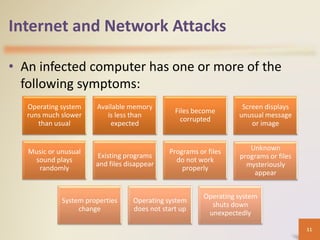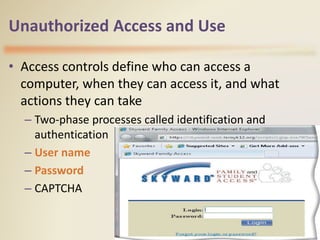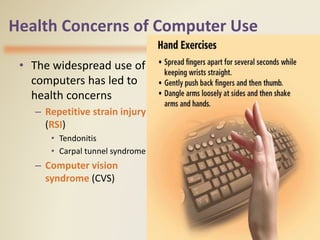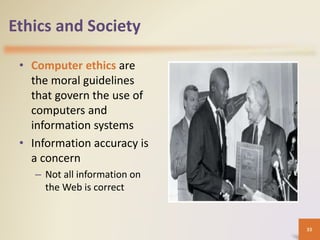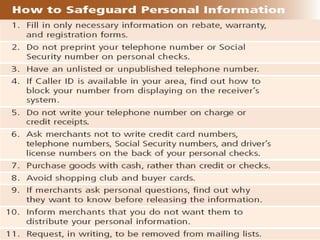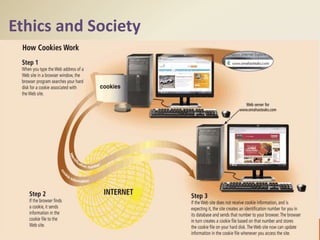Computer Security and their social effect and their usage.
- 1. Manage Computers Securely, Safely and Ethically 1
- 2. Objectives Overview Define the term, computer security risks, and briefly describe the types of cybercrime perpetrators Describe various types of Internet and network attacks, and identify ways to safeguard against these attacks Discuss techniques to prevent unauthorized computer access and use Identify safeguards against hardware theft and vandalism Explain the ways software manufacturers protect against software piracy Discuss how encryption works, and explain why it is necessary 2
- 3. Objectives Overview Discuss the types of devices available that protect computers from system failure Explain the options available for backing up computer resources Identify risks and safeguards associated with wireless communications Discuss ways to prevent health-related disorders and injuries due to computer use Recognize issues related to information accuracy, intellectual property rights, codes of conduct 3
- 4. Computer Security Risks • A computer security risk is any event or action that could cause a loss of or damage to computer hardware, software, data, information, or processing capability • A cybercrime is an online or Internet-based illegal act 4 Hackers Crackers Script Kiddies Corporate Spies Unethical Employees Cyberextortionists Cyberterrorists
- 5. Computer Security Risks • Hackers :refers to someone who accesses a computer or network illegally • Crackers : is someone who accesses a computer or network illegally but has the intent of destroying data, stealing information, or other malicious action • Script Kiddies: A script kiddie has the same intent as a cracker but does not have the technical skills and knowledge. Script kiddies often are teenagers that use prewritten hacking and cracking programs to break into computers 5
- 6. Computer Security Risks • Corporate Spies: have excellent computer and network skills and are hired to break into a specific computer and steal its proprietary data and information. • Unethical Employees: break into their employers’ computers for a variety of reasons. Some simply want to exploit a security weakness. Others seek financial gains from selling confidential information. Disgruntled employees may want revenge 6
- 7. Computer Security Risks • Cyberextortionists : is someone who uses e-mail as a vehicle for extortion. They send a company a threatening e-mail message indicating they will expose confidential information, exploit a security flaw, or launch an attack that will compromise the company’s network — if they are not paid a sum of money • Cyberterrorists: is someone who uses the Internet or network to destroy or damage computers for political reasons. The extensive damage might destroy the nation’s air traffic control system, electricity-generating companies, or a telecommunications infrastructure 7
- 8. Computer Security Risks Discovering Computers 2012: Chapter 11 8
- 9. Internet and Network Attacks • Information transmitted over networks has a higher degree of security risk than information kept on an organization’s premises • An online security service is a Web site that evaluates your computer to check for Internet and e-mail vulnerabilities Discovering Computers 2012: Chapter 11 9
- 10. Internet and Network Attacks Computer Virus • Affects a computer negatively by altering the way the computer works Worm • Copies itself repeatedly, using up resources and possibly shutting down the computer or network Trojan Horse • A malicious program that hides within or looks like a legitimate program Rootkit • Program that hides in a computer and allows someone from a remote location to take full control Discovering Computers 2012: Chapter 11 10
- 11. Internet and Network Attacks • An infected computer has one or more of the following symptoms: 11 Operating system runs much slower than usual Available memory is less than expected Files become corrupted Screen displays unusual message or image Music or unusual sound plays randomly Existing programs and files disappear Programs or files do not work properly Unknown programs or files mysteriously appear System properties change Operating system does not start up Operating system shuts down unexpectedly
- 12. Discovering Computers 2012: Chapter 11 12 • Page 559 • Figue 11-3
- 13. Internet and Network Attacks • Users can take several precautions to protect their home and work computers and mobile devices from these malicious infections 13
- 14. 14
- 15. Internet and Network Attacks • A botnet is a group of compromised computers connected to a network – A compromised computer is known as a zombie • A denial of service attack (DoS attack) disrupts computer access to Internet services • A back door is a program or set of instructions in a program that allow users to bypass security controls • Spoofing is a technique intruders use to make their network or Internet transmission appear legitimate 15
- 16. Internet and Network Attacks • A firewall is hardware and/or software that protects a network’s resources from intrusion Discovering Computers 2012: Chapter 11 16
- 17. Internet and Network Attacks Intrusion detection software •Analyzes all network traffic •Assesses system vulnerabilities •Identifies any unauthorized intrusions •Notifies network administrators of suspicious behavior patterns or system breaches 17
- 18. Unauthorized Access and Use Unauthorized access is the use of a computer or network without permission Unauthorized use is the use of a computer or its data for unapproved or possibly illegal activities 18
- 19. Unauthorized Access and Use • Organizations take several measures to help prevent unauthorized access and use – Acceptable use policy – Disable file and printer sharing – Firewalls – Intrusion detection software Discovering Computers 2012: Chapter 11 19
- 20. Unauthorized Access and Use • Access controls define who can access a computer, when they can access it, and what actions they can take – Two-phase processes called identification and authentication – User name – Password – CAPTCHA Discovering Computers 2012: Chapter 11 20
- 21. Unauthorized Access and Use • A possessed object is any item that you must carry to gain access to a computer or computer facility – Often are used in combination with a personal identification number (PIN) • A biometric device authenticates a person’s identity by translating a personal characteristic into a digital code that is compared with a digital code in a computer Discovering Computers 2012: Chapter 11 21
- 22. Hardware Theft and Vandalism Hardware theft is the act of stealing computer equipment Hardware vandalism is the act of defacing or destroying computer equipment 22
- 23. Software Theft • Software theft occurs when someone: 23 Steals software media Intentionally erases programs Illegally copies a program Illegally registers and/or activates a program
- 24. Software Theft • A single-user license agreement typically contains the following conditions: 24 Permitted to • Install the software on one computer • Make one copy of the software • Remove the software from your computer before giving it away or selling it Not permitted to • Install the software on a network • Give copies to friends or colleagues while continuing to use the software • Export the software • Rent or lease the software
- 25. Software Theft • Copying, loaning, borrowing, renting, or distributing software can be a violation of copyright law • Some software requires product activation to function fully 25
- 26. Information Theft • Information theft occurs when someone steals personal or confidential information • Encryption is a process of converting readable data into unreadable characters to prevent unauthorized access Discovering Computers 2012: Chapter 11 26 • Pages 572 - 5 • Figure 11-17
- 28. System Failure • A system failure is the prolonged malfunction of a computer • A variety of factors can lead to system failure, including: – Aging hardware – Natural disasters – Electrical power problems • Noise, undervoltages, and overvoltages – Errors in computer programs 28
- 29. System Failure • Two ways to protect from system failures caused by electrical power variations include surge protectors and uninterruptable power supplies (UPS) Discovering Computers 2012: Chapter 11 29
- 30. Backing Up – The Ultimate Safeguard • A backup is a duplicate of a file, program, or disk that can be used if the original is lost, damaged, or destroyed – To back up a file means to make a copy of it • Offsite backups are stored in a location separate from the computer site 30 Cloud Storage
- 31. Health Concerns of Computer Use • The widespread use of computers has led to health concerns – Repetitive strain injury (RSI) • Tendonitis • Carpal tunnel syndrome – Computer vision syndrome (CVS) 31
- 32. Discovering Computers 2012: Chapter 11 32
- 33. Ethics and Society • Computer ethics are the moral guidelines that govern the use of computers and information systems • Information accuracy is a concern – Not all information on the Web is correct 33
- 34. Ethics and Society Intellectual property rights are the rights to which creators are entitled for their work • A copyright protects any tangible form of expression An IT code of conduct is a written guideline that helps determine whether a specific computer action is ethical or unethical 34
- 35. 35
- 37. 37
- 38. Ethics and Society • Information privacy refers to the right of individuals and companies to deny or restrict the collection and use of information about them • Huge databases store data online • It is important to safeguard your information 38
- 39. Discovering Computers 2012: Chapter 11 39
- 40. Discovering Computers 2012: Chapter 11 40
- 41. Ethics and Society • When you fill out a form, the merchant that receives the form usually enters it into a database • Many companies today allow people to specify whether they want their personal information distributed 41
- 42. Ethics and Society • A cookie is a small text file that a Web server stores on your computer • Web sites use cookies for a variety of reasons: 42 Allow for personalization Store users’ passwords Assist with online shopping Track how often users visit a site Target advertisements
- 43. Ethics and Society Discovering Computers 2012: Chapter 11 43
- 44. Ethics and Society • Spam is an unsolicited e-mail message or newsgroup posting • E-mail filtering blocks e-mail messages from designated sources • Anti-spam programs attempt to remove spam before it reaches your inbox 44
- 45. Ethics and Society • Phishing is a scam in which a perpetrator sends an official looking e-mail message that attempts to obtain your personal and financial information • Pharming is a scam where a perpetrator attempts to obtain your personal and financial information via spoofing 45
- 46. Ethics and Society Social engineering is defined as gaining unauthorized access or obtaining confidential information by taking advantage of trust and naivety Employee monitoring involves the use of computers to observe, record, and review an employee’s use of a computer 46
- 47. Ethics and Society • Content filtering is the process of restricting access to certain material on the Web • Many businesses use content filtering • Web filtering software restricts access to specified Web sites 47
- 48. Summary Potential computer risks and safeguards Wireless security risks and safeguards Computer-related health issues and preventions Ethical issues surrounding information accuracy, intellectual property rights, codes of conduct, green computing, and information privacy 48










